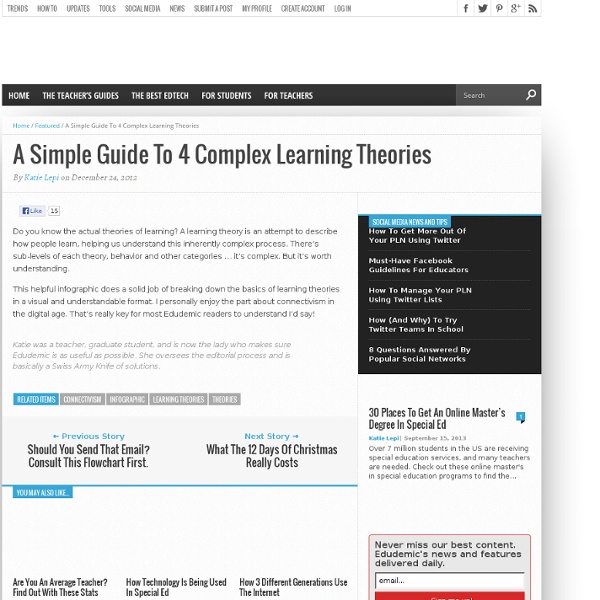



http://www.edudemic.com/a-simple-guide-to-4-complex-learning-theories/
Related: Recherches en Sciences de l'éducation • EducationCreativity Becomes an Academic Discipline Photo IT BOTHERS MATTHEW LAHUE and it surely bothers you: enter a public restroom and the stall lock is broken. Fortunately, Mr. Lahue has a solution. The 7 characteristics of a digitally competent teacher Being a proper digitally competent teacher is not as simple as picking up an iPhone and tweeting. You need to be a good digital citizen, understand privacy, and more. In an effort to clarify and explain some of the most important characteristics that a digitally competent teacher must have, we whipped up this fun visual. It’s designed to make it abundantly clear which skills you should have, who should consider themselves ‘digitally competent’ and more. We know the audience of Daily Genius is a lot more than just teachers – so we hope you find some value in this graphic even if you’re not a teacher. After all, being a good digital citizen and understanding privacy (just 2 of the characteristics) are some of the most important things anyone using the Internet should understand.
Classical Conditioning 1903 - Ivan Pavlov discovers Classical Conditioning Theory, while conducting research on the digestive system of dogs. Later classical conditioning theory was applied to humans by John B. Watson. Check the Instructional Design Models and Theories: Classical Conditioning article and presentation to find more. How 17-Year-Old Nikhil Goyal Is Disrupting Education At 17 years old, Nikhil Goyal is shaking up America’s education system. Goyal is a senior at Syosset High School, a public school in New York. While most high school students focus on athletics, academics, and socializing, Goyal aims to transform the American education system. Goyal’s book, One Size Does Not Fit All: A Student’s Assessment of School ,describes the flaws within America’s education system and provides solutions to fix the present challenges. He explains the importance of finding progressive leaders to transform our nation’s education system. “Everybody is born with innate curiosities,” Goyal said.
Instructional Development Timeline Robert Gagne (1916-2002) Education Yale, A.B. 1937Brown, Ph.D. 1940 Career Highlights Professor, Connecticut College (1940-49)Professor, Penn State University (1945-46)Director of Perceptual and Motor Skills Laboratory, U.S. Five-Minute Film Festival: Classroom Makeovers to Engage Learners Most educators have little choice about the (usually) over-crowded, (often) unappealing rooms they teach in -- but they intuitively know that the spaces children spend their time in can have an effect on how they learn. I've gathered a collection of videos to explore the questions: How important is environment to learning? And what small changes can you make in seating, organization, lighting, and decor to build your own space into a better place to teach and learn?
6 Powerful Strategies For Deeper Learning In Your Classroom 6 Powerful Strategies For Deeper Learning In Your Classroom by Dr. Monica R. The ADDIE Instructional Design Model Infographic Instructional Design Infographics The ADDIE Instructional Design Model Infographic The ADDIE instructional design model is possibly the best-known instructional design model. The ADDIE model refers to Analyze, Design, Develop, Implement, and Evaluate. Furthermore, provides a step-by-step process that helps instructional designers plan and create training programs with a framework in order to make sure that their instructional products are effective and that their processes are as efficient as they can possibly be. Analyze In the analysis phase, the instructional problem is clarified, the instructional goals and objectives are established, and the learning environment and learner’s existing knowledge and skills are identified.
Why It's Time to Eliminate Class Schedules I spend a lot of time in a philosophical tug-of-war with students and parents over what grades mean, why we give them, and how they should be interpreted. Parents want to know how their child is doing, students want to be left alone, and teachers just want everyone to think a bit more critically about the material. We end up with conflicting pressures, and a grading system that has overstepped its bounds with disastrous results for student psychology. Cheating, lying, extra credit for bringing in a box of Kleenex—it’s all the same disease.